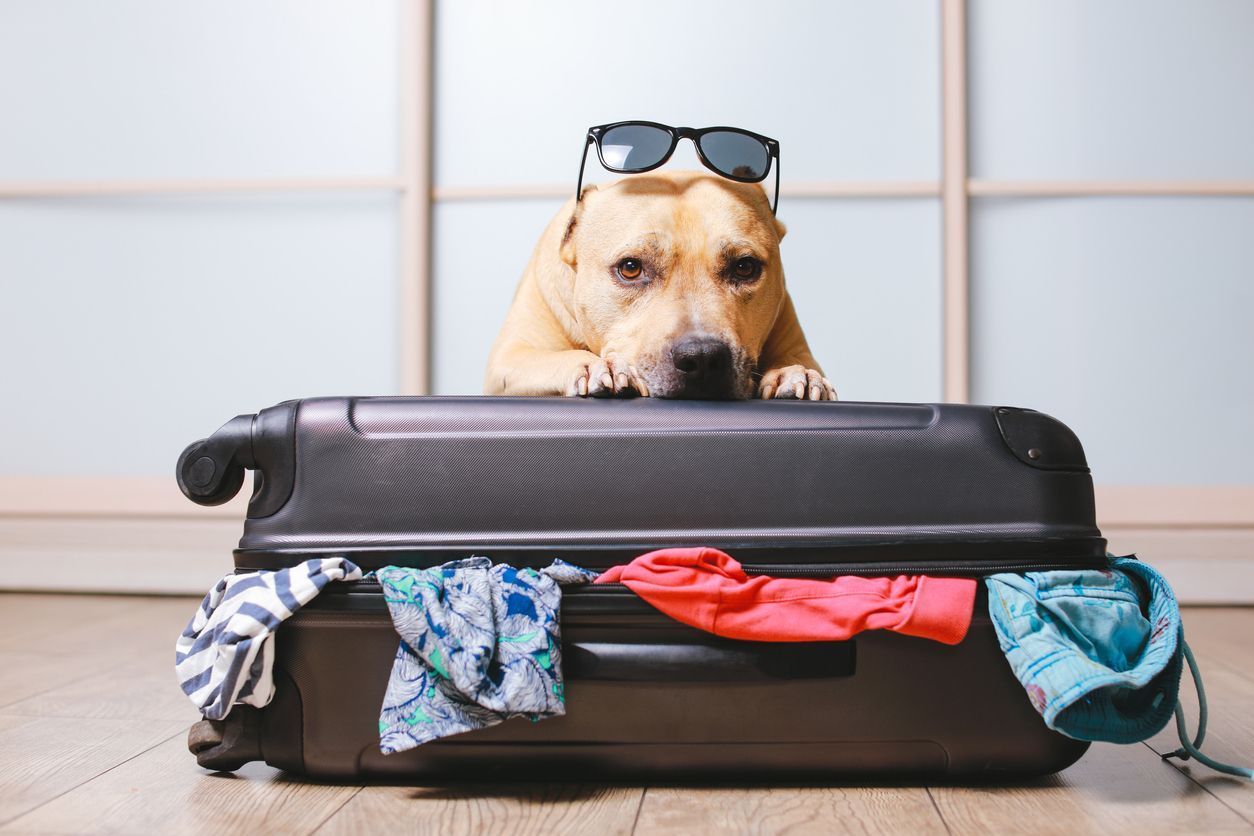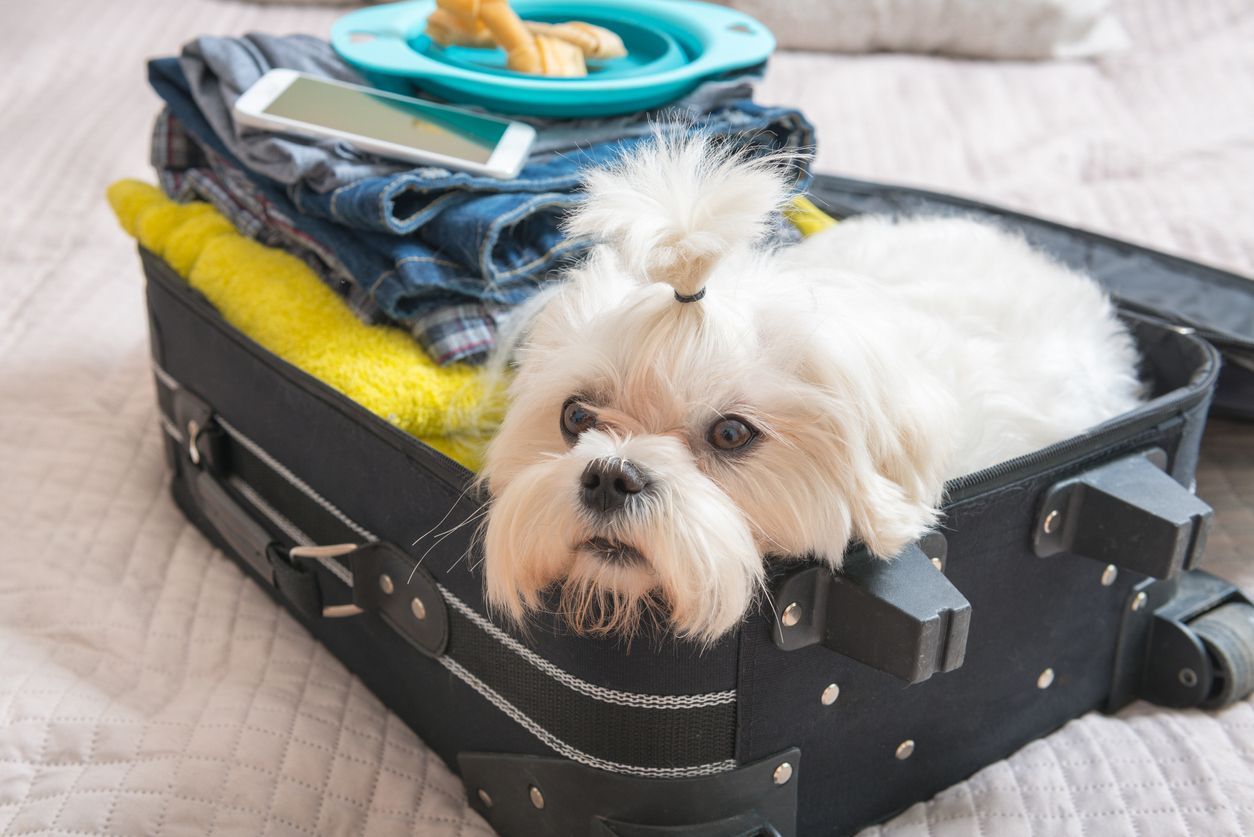Pet boarding during the holidays: Everything you need to know

These days, the traditional 12 Days of Christmas stretch from the day after Halloween until the schnapps runs out sometime just before President’s Day. Depending on how you do things, that means a lot of family time—a lot of travel, even.
And although Fido is a part of the family, sometimes you’ll have to end up boarding them: due to the urgent nature of a trip, the cost involved, or specific airline rules, you may not have the option of traveling with your pet.
Boarding your pet can be a scary prospect; to be sure, pet care while on vacation isn’t a matter to be taken lightly. But we’re here to take the worry out of it. Below, we’ll go over everything you need to know.
Types of pet boarding facilities
There are different types of pet boarding facilities, each of which serves a different need.
Dog kennels
Dog kennels are the classic pet boarding scenario. Generally, each dog gets their own kennel. They’re let out to play and use the restroom regularly, and fed according to individual dietary needs. Kennel attendants also make sure dog kennels are clean, and that dogs that need it are bathed. If they have the necessary certification, kennel workers can also groom dogs.
Cat boarding
Cat boarding facilities usually allow cats to roam more freely than kennels allow dogs to do. This makes sense: cats aren’t generally as social as dogs, meaning they’re relatively unlikely to interact with each other and possibly fight if a meeting goes haywire. At some locations, cats with specific needs can even be boarded independent of other cats.
Cat boarding often looks more like a cat resort than a kennel. These luxurious cat hotels offer all your feline pal could want, such as:
- Windowed lounges
- Sunrooms
- Scratching posts
- Open-area playrooms
Frankly, it’s probably nicer than where you’re staying. Which should offer some peace of mind.
Veterinary office
Many veterinarians offer in-office boarding, which is a great option since the veterinary professionals that work there are already familiar with your pet’s particular needs.
You also already know what your veterinarian’s office looks like, so you aren’t going into an unknown situation worrying about kennel conditions, the relative attentiveness or inattentiveness of employees, and so on.
In-home boarding
If you don’t care for larger-scale kennels, private in-home boarding may be the way to go.
In theory, it’s like having a friend watch your pet, except you pay the friend and don’t really know who they are. And they don’t know your pet, either. But you do have the option of boarding either in your home or in your boarder’s. So make sure you bring what you need and explain your pet’s needs clearly.
That said, the benefits of private in-house boarding include more one-on-one attention, and sometimes prices can be negotiated. This option is growing in popularity with the help of apps like Rover that bring pet parents and private boarders together.
Choosing a boarding facility
Let’s go over how to choose the appropriate boarding facility.
Do your research
There are many different types of boarding facilities, which has pros and cons.
Federal pet boarding standards don’t exist, and what regulations there are vary by state and city. For instance, New York City requires a $70 small animal boarding facility application, renewed each year, permit obtained from the Department of Health and Mental Hygiene (DOHMH). However, you can’t operate a kennel out of your own home (in NYC, at least), making private in-house pet boarding a bit tricky.
Ask fellow pet parents, your veterinarian, or any other trusted professional who works with animals about the reputation of the facility you’re considering. Ask specific questions, such as:
- How big are the kennels?
- Are animals boarded in individual kennels?
- How many attendants do they have on staff?
- How frequently is the facility cleaned?
- How often do they let animals out for free play?
There are plenty of reputable kennels available, but as long as you do your homework, you should be able to find a suitable option. It’s hard enough leaving your pet behind while you take a trip, so make sure you ask plenty of questions and ask around for recommendations or reviews to feel confident in your selection.
Visit the facility
Make an appointment to drop by a boarding facility before boarding your pet for the first time. See for yourself how much room the animals have and what the attendants are like. Ask detailed questions, and observe the animals there. Do they seem happy, or at least comfortable? Are an unusually high number of them displaying fearful behavior?
It may not be feasible to visit a kennel ahead of time if you need to leave town quickly, but if you have the opportunity to plan your pet’s boarding experience ahead of time, it’s a good idea to check the place out for yourself—especially if you expect to board your pet for an extended stay.
Book a trial stay
Book your pet a night at a kennel and see how they do. Some animals warm up to new people and tolerate new situations fairly readily, others take more time to warm up to new surroundings.
If your pet comes back to you in good shape—and perhaps doesn’t seem to want to leave the kennel attendants—that’s a good sign. It’ll be easier for your pet when you take them back to board them for longer periods.
Meeting boarding requirements
Before you can book a stay at a boarding establishment, your pet must meet certain requirements.
For dogs
The core vaccines required for dog boarding are:
- Parvovirus
- Distemper
- Hepatitis
- Rabies
- Bordetella (one of the pathogens associated with kennel cough)
Certain facilities may also require Leptospirosis and canine influenza vaccines. All vaccines need to be up to date, and it may also be a good idea for you to have your dog on a parasite prevention plan.
Whether fully vaccinated or not, some dogs simply aren’t temperamentally suited to certain boarding situations. Those that are easily stressed, previously traumatized, have extensive medical needs, or don’t socialize well with other dogs will need to work on their behavior before they can be boarded.
While standards vary from boarder to boarder, your dog may also need to have attained a certain obedience level. They don’t need to be able to jump through flaming hoops. But dogs that aren’t housetrained or have poor impulse control may present a problem for boarders.
For cats
The core cat vaccines are:
- Panleukopenia (feline distemper)
- Feline calicivirus
- Feline herpesvirus type I (rhinotracheitis)
- Rabies
The Bordetella vaccine is also often recommended. Other vaccines are given based on your cat’s lifestyle. These include:
- Feline leukemia virus
- Chlamydophila felis
- Feline immunodeficiency virus
Most cats aren’t as reactive as dogs, so temperament issues are less of a concern. However, the same rules apply to cats as to dogs, and some boarders may not accept fearful or antisocial cats.
Pet boarding: what to bring
Pet boarders provide most of what you need. But we all like to take some of our favorite things with us on vacation. Here’s what to pack for dog boarding.
Leash, collar & tags
It’s important to bring your pet’s collar and tags along. Boarders are often professionals, and kennels are generally secure, but for some particularly intelligent or rambunctious dogs, there’s always an escape risk. You can also opt to bring your pet’s leash as well, for familiarity’s sake.
Medications & documentations
Make sure boarders are familiar with your pet’s medication regimen and what they need to do to properly administer it. Bring a copy of your pet’s vet records—especially vaccination records—as well as pet insurance details.
Preferred food & snacks
Many animals thrive on routine. So don’t change things up much: bring your pet’s preferred food and snacks along. If your pet requires a special diet, be sure to not only bring food and treats, but also explain to kennel staff what foods are dangerous for your pet.
Familiar toys & bedding
Bring their favorite toys and familiar bedding. Being boarded is stressful enough, so keep things as familiar as possible. To that end, it’s not a bad idea to include a recently worn t-shirt along with your pet’s bedding. Your scent will comfort them—it’s the next best thing to you actually being there.
Emergency contact info
Be sure to leave your personal cell phone number, as well as any other relevant contact information, with your pet’s boarders. It may even be useful to also give information for a local contact you trust who can be reached in case of a time-sensitive emergency.
Tips for boarding your dog for the first time
It can be scary boarding your dog for the first time—for both your dog and for you. But there are ways you can prepare.
Practice sleep and crate training
Dogs who sleep independently—that is, not in your bed—are more likely to adapt to kenneling easily.
If your dog does sleep with you, you may want to try crate training. Depending on your dog’s age and temperament, crate training can take up to six months—and that’s with a concerted effort on your part. But if you have the time, it’s worth it. Crate training can help alleviate anxiety in general, and reduce kenneling fear in particular.
Get your pup comfortable with other dogs
Dogs are naturally social, but also highly individual. In order to truly know how your dog will interact with other dogs, you’ll need to introduce them (safely) to other dogs.
Dog parks can be a great option. Your pup can run free with a new pal. You could also introduce your dog to neighborhood dogs on a walk, or to friends’ dogs in a more controlled indoor environment.
When introducing dogs to each other, make sure they’re both leashed, and separate them if one becomes aggressive. Once being around other dogs is normalized, your pup will likely relax and possibly even love hanging out with their fellow canines.
Ensure a stress-free drop-off
Dogs can be excellent at understanding tone and body language. Keeping this in mind can ease drop-off stress. Try not to seem sad or nervous when you drop your pup off. Act like it’s an adventure for them: bring their favorite toys, talk excitedly, and generally act like you wish you could be boarded in a kennel. They may pick up on your behavior and respond positively.
After you bring your pet home
If everything goes well, your pet just may thank you for boarding them. They got to hang out with other animals, perhaps received a little pampering, satiated curiosity by exploring a whole new environment, and got lots of attention from people who care for pets for a living.
Pets should acclimate to life back home fairly easily, although the longer their time away, the more difficulty they may have returning to their home environment. As a result of stress or excitement, they may eat or drink excessively as soon as they get home. Their sleep and play schedules will likely be set according to the kennel’s, so you’ll have to get them back to normal.
On the other hand, a pet may act sullen or distant upon returning home. This can be a normal response to being transported between different environments. But if your pet’s personality seems significantly altered for more than a day, make an appointment to speak with a veterinary professional and get an accurate understanding of possible issues.
Vetster offers online virtual care appointments from the comfort of your home, so you don’t need to pack up your pup just as they’re trying to get settled. Thousands of top-rated vets are available 24/7, and happy to help your furry friend get back on track.



